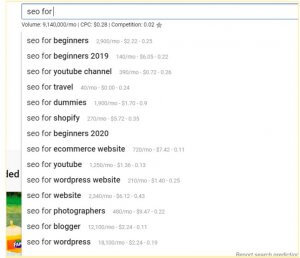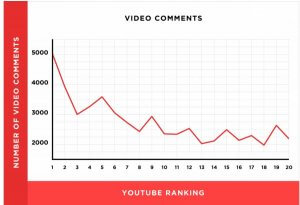You have spent hours shooting, editing and perfecting your video. You upload it to YouTube and the thousands of views you anticipated do not even come close. What went wrong?
SEO for blogs and websites is integral in getting page views, but did you know the same is true for your video content? YouTube SEO, and video SEO in general, is different from the SEO tactics that you may be used to using on your website.
Here I will break down how the proper YouTube SEO techniques for your videos to ensure that you are red carpet ready for your content’s debut.
How to Rank on YouTube Using SEO
YouTube has 2 billion logged-in monthly users, which is more than both Facebook and Instagram. It is the second largest search engine to date, second only to Google. If you are spending budget on other social media platforms but have neglected to look into YouTube, especially in 2021, you could be missing out on the chance to target a large demographic.
Having a presence on YouTube isn’t the only thing that will drive users to you, we wish it was that easy. You need to optimize your videos to ensure they perform at their utmost potential.
YouTube SEO involves optimizing your channel, playlists, metadata descriptions, and the videos themselves. You can optimize your videos for search both within and outside of YouTube.
How to Optimize YouTube Videos
A key component to YouTube SEO is taking advantage of the power of your video’s text in the form of transcripts, closed captions, and subtitles. Luckily, Google and YouTube share data seamlessly, so you do not have to wait for bots to index your video.
Here are some steps you should be taking to make sure your video reaches the right audience, or even make it go viral.
Choose Your YouTube Keywords
Creating a successful video takes a lot of planning and detail which includes choosing the right keyword for your video. Think, ‘what is the purpose of this video?’ Remember, if a user has visited your site, then they already are interested in what you are presenting, so you do not need to hard-sell them on the product or service. Your videos should be broadly informative. With that in mind, how do you discover the right keywords?
You can actually find great keyword ideas on YouTube itself. Just click on the search bar, type in what you think your priority keyword would be and look at the suggested searches. Downloading Keywords Everywhere can also be helpful when it comes to researching keywords. Every time you search in Google or YouTube, Keywords Everywhere will give you the monthly search volume and the estimated cost-per-click.

Optimized Video Title
This is a given. A video can not go viral if Google does not understand what it is about. An optimized title is only the first step in helping Google understand what your video is about. But your title is also audience facing. Be sure to provide your priority keyword in your title. Backlinko even conducted research on this topic, discovering that with an exact keyword match in a title, video’s performed better than those that did not. Be sure to find a keyword that balances what is happening in the video and search volume.
Remember, you should not be stuffing your title with multiple keywords, but rather one focus. If there are other supporting keywords that you would like to try and rank for, include them as video tags and in your video description. You can have up to twenty tags on a video, so use this to your advantage.

Source: https://backlinko.com/youtube-ranking-factors
Video Tags: Do Not Overdo It
As we just mentioned, you can have up to twenty tags on a video. What is important to remember is that an excess use of tags can be similar to “keyword stuffing” a blog. If you add a dozen irrelevant tags, the bots crawling will not understand what your video is about. It is best practice to have 5 to 8 tags that relate to your videos theme, including your primary keyword. Long-tail keywords are also considered valuable on YouTube. Tags are helpful for when it comes to showing up in the playlists under “related videos”, and this will give you more exposure.
Provide a Video Transcript
Providing a video transcript is a powerful tool when it comes to optimizing your YouTube video. Video transcripts make your videos more accessible to a larger audience and they make your videos easier to search by bots since there’s additional text on the page. Adding a transcript can also increase your chances of showing up as a related video. Veed has a transcription service for free as well as other paid options. Another tool, Scribie, can transcribe your video for 10 cents per minute. You can copy and paste a transcript from YouTube, however, this is bound to have issues. If you choose to download from YouTube, you should comb over the transcript and fix errors as you see them manually. This can be time consuming and still leave room for error so it is usually seen as more beneficial and efficient to set apart a budget for transcription services.
Do Not Use YouTube’s ASR Captions
When you are in a rush to upload a video, it may seem tempting to use YouTube’s ASR captions. That tool is only 70% accurate and can lead to incorrect or even downright embarrassing translations.
A notable case of this took place back in 2011, when the BBC came under fire for terrible subtitling. For example, during the Queen Mother’s funeral, a call for silence became “‘we will now have a moment’s violence’!” Not what you would want to be promoting.
Even though it takes time, it is more beneficial and much more accurate to take charge of your own transcripts. Whether that is sending it to a professional video transcription service or finding a do it yourself solution!
Search engines can only crawl text, they can’t watch your video. Be sure that your video transcript is full of relevant keywords that tell what your video is about so that Google can crawl your content and rank you properly.
Use Video SEO Embed
Google prioritizes video in the search results. That is why you often see videos first when conducting a google search. Most popular paid hosting solutions allow you to define where your content can be embedded. You will also need to ensure that your video player will not display an “embed” button as an overlay or box beneath the video. You want to make sure the video that you created is being watched on your domain so that you get the credit for it!
Those are just a few ways that you can make sure that your video is ready for YouTube’s search engine optimization process. YouTube SEO takes time to perfect but the results are worth the effort. Check out this blog for more tips on how you can use video for your B2B content promotion
